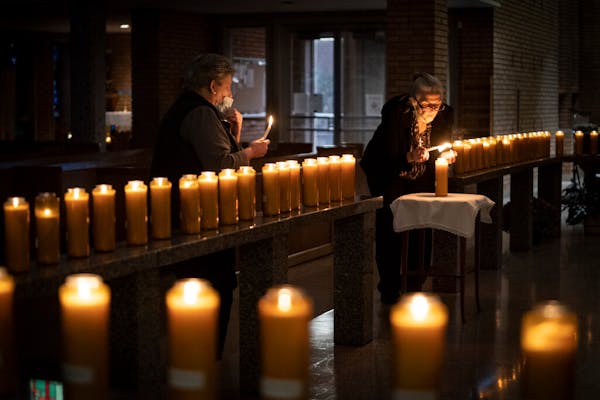Minnesota health officials took no comfort Monday in seeing Wisconsin's COVID-19 numbers surge past their own, because they fear there could soon be little difference between the two.
Wisconsin posted fewer infections and COVID-19 deaths all spring and summer — a disparity that put Minnesota health officials on the defensive about their pandemic response — but passed Minnesota on Sept. 11.
Wisconsin now has 232,296 known infections compared with Minnesota's 153,620. It has reported 702 deaths since Oct. 1 compared with Minnesota's 436.
State infectious disease director Kris Ehresmann said she hopes Minnesotans treat the comparison more like a mirror than a scoreboard, because Minnesota is on a similar trajectory without more mask-wearing, crowd avoidance, social distancing and other measures to slow the spread of the coronavirus that causes COVID-19.
"It's not a competition between the states," she said. "We want to learn what we can from our partners in Wisconsin, but we want to recognize we are in a very precarious place in Minnesota."
Minnesota is surrounded by four states with the nation's highest infection rates, but state leaders have looked east for comparisons because of Wisconsin's similar geography and urbanization. Minnesota's new infection rate is 427 per million people per day, according to the COVID Exit Strategy website, while Wisconsin's rate is 798 and the Dakotas are above 1,300.
Of concern are reports in Wisconsin of hospital bed and staff shortages. Minnesota hospitals reported record COVID-19 activity over the weekend and a total on Monday of 774 patients admitted with the infectious disease — including 195 needing intensive care — but have not curtailed hospital activities as they did in the spring.
In Wisconsin, Mayo Clinic last week suspended nonessential procedures at its hospitals in and around Eau Claire and brought in nurses from Rochester, Minn., to cover shifts for colleagues this weekend who couldn't work because of infections or quarantines.
In Milwaukee, 12 patients with COVID-19 are being treated at a makeshift hospital on the state fairgrounds because of bed shortages. "That was our ultimate insurance policy and we are utilizing it now," said Andrea Palm, secretary-designee of the Wisconsin Department of Health Services. "That is not where we want to be."
While COVID-19 doesn't recognize borders, comparisons of state COVID statistics were inevitable given the lack of a national pandemic response that forced governors to chart their own.
Politics fueled the Minnesota-Wisconsin comparison, because the states charted similar responses of business and school shutdowns this spring until a May court ruling struck down the emergency order Gov. Tony Evers used in Wisconsin. That left Gov. Tim Walz justifying his emergency actions in Minnesota to Republican lawmakers who looked across the border and saw greater pandemic progress in the absence of state restrictions.
Concern has grown in places such as Eau Claire, where the infection rate is among the highest in Wisconsin.
On Friday, the state's COVID-19 drive-through testing site off Hwy. 312 saw more action than the Fire House tavern in Eau Claire. Tavern manager Chance Smith sat behind a makeshift Plexiglass enclosure, notifying customers that only carryout service was available. A health problem leaves Smith, 24, at greater risk of severe illness. "I've gone from not knowing anyone who had been infected to knowing several people who are," he said. "It's getting closer every day, and that makes me increasingly worried about my own health. People are getting sick and are dying. It's a mess."
Nurse Dustin Hein volunteered on his weekend off from working in a cardiac ICU at Mayo Clinic in Rochester to staff the general ICU in Eau Claire. Flipping a patient into the prone position to support lung function can take several nurses, or half the ICU.
"I know how it feels to be short-staffed," he said. "If I'm able to go out there and help them at least get through the weekend, that was the main driver."
Minnesota still has reported more COVID-19 deaths than Wisconsin — 2,484 vs. 2,050, respectively — due to spring outbreaks in long-term care facilities where older and sicker residents are particularly vulnerable. Health officials suspect the differing pace of infections in Minnesota and Wisconsin partly has to do with how the first wave concentrated on high-density urban areas — with the Twin Cities being larger than Milwaukee. The second wave of infections this fall has spread in rural counties, where compliance with mask-wearing and other mitigation strategies appears lower.
Mask-wearing levels are above 90% in the Minneapolis and Milwaukee areas, but drop to 82% in nonurban sections of Wisconsin, and 84% in Minnesota, according to Carnegie Mellon University's COVIDcast. Rural rates in the Dakotas are below 70%.
"The whole country is now experiencing 'COVID fatigue,' " said Dr. Richard Helmers, a regional vice president for Mayo's health system in northwestern Wisconsin, "and perhaps due to the low numbers, Wisconsin residents became less concerned about the pandemic and have not been as adherent to the social distancing and masking guidelines."
Both states have mask-wearing mandates for indoor public spaces. Iowa and the Dakotas don't.
Genomic sequencing of virus samples could detail exactly how the virus spread in different paths through Minnesota and Wisconsin, but the number of samples for that kind of mapping is lacking. Gundersen Health System in La Crosse has been doing much of this sequencing work, and the growth in communities sending samples is telling.
In May, Gundersen was collecting from 33 municipalities. Now, 150 communities are sending samples. Dr. Paraic Kenny, who is leading the sequencing work, said rural communities got lulled into lax compliance, which meant the virus hit them harder when it arrived. "It found a susceptible population that had grown pretty relaxed about protective measures," he said. "In that setting, even the introduction of a couple of cases can lead to big growth due to churches, potlucks, bars, family gatherings, etcetera."
Jeremy Olson • 612-673-7744

Daughter sues St. Paul, two officers in Yia Xiong's killing

